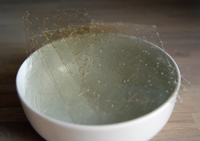
Photo from wikipedia
To improve the efficient use of nitrogen and decrease the environmental pollution of N losses, a novel and biodegradable composite hydrogel was prepared by chemical cross-linking synthesis using gelatin (Gel),… Click to show full abstract
To improve the efficient use of nitrogen and decrease the environmental pollution of N losses, a novel and biodegradable composite hydrogel was prepared by chemical cross-linking synthesis using gelatin (Gel), chitosan (CS) and polylactic acid (PLA) as raw materials. Urea as the nitrogen source was loaded into this new biodegradable hydrogel using the solution immersion method. The chemical structures of the composite hydrogels were characterized and their properties were analyzed by XRD and XPS. The regulation of urea loading and the swelling behavior of the composite hydrogel under different temperature conditions were investigated; the release behavior and release model of the composite hydrogel in the aqueous phase was explored. The results show that the loading of urea is controllable in aqueous urea solution with different concentrations. In the water phase, it shows a three-stage sustained release behavior, that is, the initial release rate of urea is relatively fast, and the medium release rate of urea gradually slows down, and finally the nutrient release rate tends to be flat. The release behavior in the water phase fits to the Ritger–Peppas model. Within 10 min, 180 min and 900 min, the cumulative nutrient release rate of gelatin/chitosan/PLA-urea (GCPU) composite hydrogel is 20%, 70% and 86%, respectively. Compared with pure urea, The urea diffusion time of GCPU was extended by 1350-times. In addition, the GCPU also has good water absorption and water retention properties, in which average water content can reach as high as 4448%. All of the results in this work showed that GCPU hydrogel had good water absorption and retention and N slow-release properties, which are expected to be widely used in sustainable agriculture and forestry, especially in arid and degraded land.
Journal Title: Polymers
Year Published: 2023
Link to full text (if available)
Share on Social Media: Sign Up to like & get
recommendations!